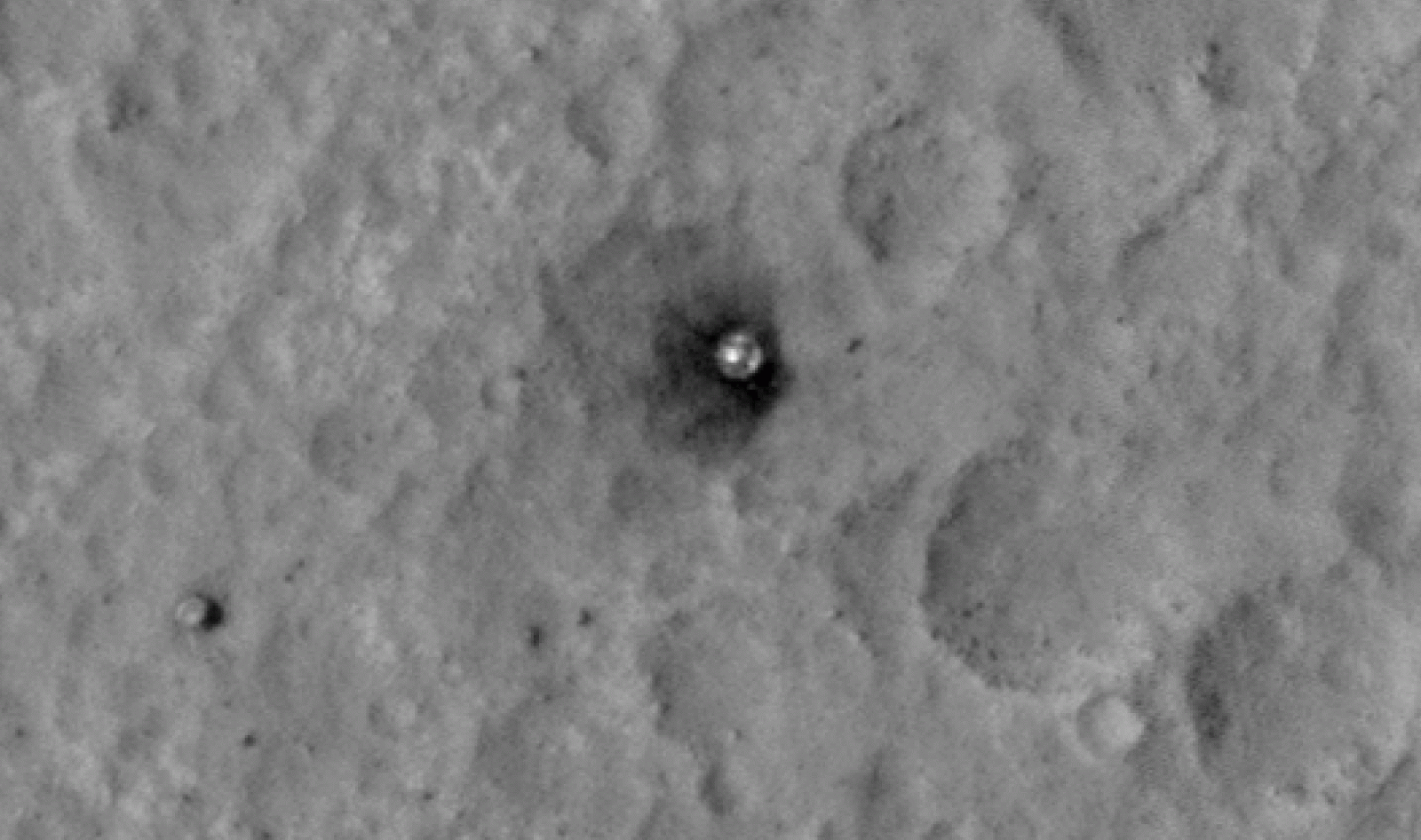NASA - Mars Reconnaissance Orbiter (MRO) logo.
March 28, 2015
Animation above: This sequence of images shows a blast zone where the sky crane from NASA's Curiosity rover mission hit the ground after setting the rover down in August 2012, and how that dark scar's appearance changed over the subsequent 30 months. Image Credit: NASA/JPL-Caltech/Univ. of Arizona.
A series of observations from Mars orbit show how dark blast zones that were created during the August 2012 landing of NASA's Curiosity rover have faded inconsistently.
The High Resolution Imaging Science Experiment (HiRISE) camera on NASA's Mars Reconnaissance Orbiter made the observations on multiple dates from landing to last month. After fading for about two years, the pace of change slowed and some of the scars may have even darkened again.
Figure 1
- Figure 1 is a sequence showing the spacecraft's back shell and parachute. Wind causes changes in the shape of the parachute as well as fading of the dark zone visible around the back shell in initial frames. Image credit: NASA/JPL-Caltech/Univ. of Arizona.
The images track changes in blast zones at four locations caused by different pieces of Curiosity hardware, such as the heat shield and the descent stage. The four series, each with images from five to seven different dates since landing, are available online at: http://www.jpl.nasa.gov/spaceimages/details.php?id=PIA19159
"Spacecraft like Curiosity create these dark blast zone patterns where bright dust is blown away by the landing," said Ingrid Daubar, a HiRISE team scientist at NASA's Jet Propulsion Laboratory, Pasadena, California, who has used similar blast zones to find fresh meteor impact sites on Mars. "We expected to see them fade as the wind moved the dust around during the months and years after landing, but we've been surprised to see that the rate of change doesn't appear to be consistent."
Figure 2
- The Figure 2 sequence shows where the rover itself landed. Curiosity disappears after the first two of the seven frames because it drove away. Its wheel tracks heading generally east (toward the left) can be seen in subsequent frames, and they also fade over time. Image credit: NASA/JPL-Caltech/Univ. of Arizona.
One purpose for repeated follow-up imaging of Curiosity's landing area has been to check whether scientists could model the fading and predict how long it would take for the scars to disappear. Daubar's work on this aids preparations for NASA's next Mars lander, InSight, on track for launch in March 2016. The InSight mission will deploy a heat probe that will hammer itself a few yards, or meters, deep into the ground to monitor heat coming from the interior of the planet. The brightness of the ground affects temperature below ground, because a dark surface warms in sunshine more than a bright one does.
Figure 3
- Figure 3 is a five-frame sequence of the location where the spacecraft's heat shield hit the ground. Image credit: NASA/JPL-Caltech/Univ. of Arizona.
HiRISE is one of six instruments with which NASA's Mars Reconnaissance Orbiter has been studying Mars since 2006.
NASA's Mars Science Laboratory Project has been using the Curiosity rover to examine ancient Martian environments favorable for microbial life.
With three active NASA Mars orbiters and two Mars rovers, NASA seeks to characterize and understand Mars as a dynamic system, including its present and past environment, climate cycles, geology and biological potential. In parallel on its journey to Mars, NASA is developing the capabilities needed for human missions there.
Mars Reconnaissance Orbiter (MRO). Image Credits: NASA/JPL-Caltech
The University of Arizona, Tucson, operates HiRISE, which was built by Ball Aerospace & Technologies Corp. of Boulder, Colorado. JPL, a division of the California Institute of Technology, Pasadena, manages the Mars Reconnaissance Orbiter Project, the Mars Science Laboratory Project and the InSight Project for NASA's Science Mission Directorate, Washington. Lockheed Martin Space Systems, Denver, built the orbiter and collaborates with JPL to operate it.
Links for additional info:
About HiRISE: http://hirise.lpl.arizona.edu
About NASA's Mars Reconnaissance Orbiter: http://mars.nasa.gov/mro
About Curiosity and NASA's Mars Science Laboratory Project: http://mars.nasa.gov/msl
About InSight: http://insight.jpl.nasa.gov
Animations (mentioned), Text, Credits: NASA/JPL/Guy Webster.
Best regards, Orbiter.ch






